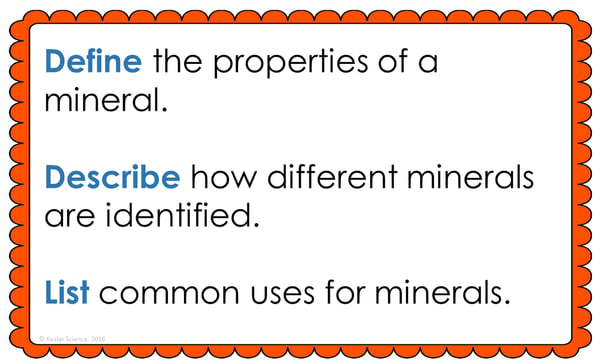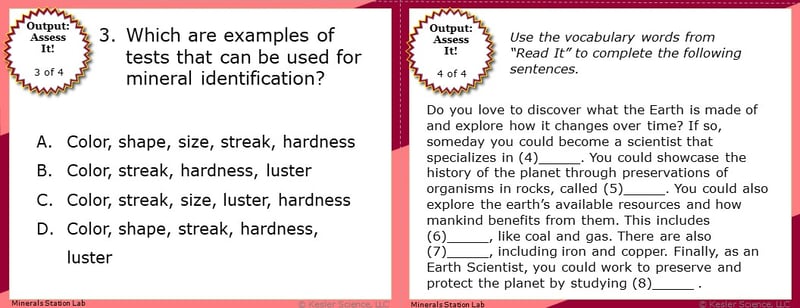Properties of Minerals Lesson Plan - A Complete Science Lesson Using the 5E Method of Instruction
By the end of this lesson about the properties of minerals, students will be able to define the properties of a mineral, describe how different minerals are identified, and list common uses for minerals. Each of our lessons is designed using the 5E method of instruction to ensure maximum comprehension by the students. This well-thought out unit does the heavy lifting, giving teachers easy-to-implement, highly engaging lesson plans.
This blog will walk you through each of the steps and activities from the Properties of Minerals 5E Lesson Plan.
ENGAGEMENT
Objective Introduction
At the beginning of the lesson, the class will do a Think-Pair-Share to discuss the objective.
Class Activity
Have students make a T-Chart on their paper with the heading “Rocks” and ” Minerals”. Ask them to write down three things they already know about rocks and three things they already know about minerals.
Student Activity
- Working in pairs or triads, give each group four to six rocks and four to six minerals.
- By observing the specimens, have the students classify them into which category they think they belong to. Either rock or mineral.
- Have them write down a few general observations as to why they classified them the way they did. You can choose to tell them the right answers, or wait and let them discover the differences as they progress through the lab and explanation portion of the lesson.
- Explain that over the next few days students will be learning about the similarities and differences between rocks and minerals, what determines whether or not something is a mineral, and how to identify minerals and their common uses.

The teacher will help to clear any misconceptions about properties of minerals. A major misconception is that students may think rocks and minerals are the same things.
Estimated Class Time for the Engagement: 20-30 minutes
EXPLORATION
This student-centered station lab is set up so students can begin to explore the properties of minerals. With nine stations in total, you can introduce these properties to your middle school students in a variety of ways! Four of these stations are considered input stations where students will learn new information about mineral properties, and four of the stations are output stations where students will be demonstrating their mastery of the lesson's material. A bonus station offers challenges for your early finishers and independent learners. You can read more about how I set up the station labs here.
Watch It!
At this station, students will be watching a short video explaining minerals. Students will then answer questions related to the video and record their answers on their lab station sheet. For example: What four criteria must be met in order to be a mineral? What is the definition used in the video for hardness? Provide at least three examples of precious stones or gemstones from the video.
Read It!
This station will provide students with a one-page reading about properties of minerals. Students will read about the importance of earth minerals and how their properties help us determine their identity. There are four follow-up questions that the students will answer to demonstrate their comprehension of the reading material.
Explore It!
Students will be working in pairs to better understand the properties of minerals. Students will be using a table to determine their hardness along with a number of mystery minerals that students will have to determine their streak, color, cleavage, and luster. Students will record their observations on their lab sheet.
Research It!
The research station will allow students to observe minerals collected in their virtual mineral box. Students will be able to learn about the different streak colors, hardness, and luster of each mineral. Students will be instructed to complete a few tasks and record answers on their lab sheets.
Organize It!
The Organize It station allows your students to organize pieces to determine whether the statement is a test for minerals or not. Once students have completed their organization, the teacher will come and check their understanding.
Illustrate It!
Your visual students will love this station. Students will draw a picture that represents each of the 5 tests for identifying a mineral. Tests include color, streak, hardness, luster, and cleavage.

Write It!
Students who can answer open-ended questions about the lab truly understand the concepts that are being taught. At this station the students will be answering three task cards: Describe how you would use a streak plate to determine a mineral’s streak. How do geologists determine the hardness of a mineral? Why would it be important for geologists to be able to do these tests in the field?
Assess It!
The Assess It station is where students will go to prove mastery over the concepts they learned in the lab. The questions are set up in a standardized format with multiple choice answers. Some questions include: How is luster used for mineral identification? Which test would most likely be helpful for determining how a mineral breaks? Which are examples of tests that can be used for mineral identification? Why is it important to not identify a mineral based on color alone?

Challenge It! - Bonus Station
Early finishers and advanced students will love the extension activities in this station. Four activity choices offer them ways to expand their learning through mini-games and mini-projects.
Estimated Class Time for the Exploration: One or two 45-minute class periods
EXPLANATION
The explanation activities will become much more engaging for your class once they’ve completed the exploration station lab. During the explanation piece of the lesson, the teacher will be clearing up any misconceptions their students may have about the properties of mineral with a variety of materials. These materials include on-level and modified versions of the interactive presentation (may be used individually or projected), anchor charts, and paper or digital interactive notebook activities. If you have students that need modified notes, the 5E lessons come equipped to help give every student access to the lesson.
Interactive notebook samples: Above-left is a digital INB activity slide; above-right is an example of the paper INB activities.
The students will also be interacting with their journals using INB templates for properties of minerals. Each INB activity is designed to help students compartmentalize information for a greater understanding of the concept. The properties of minerals INB templates allow students to focus their notes on understanding the how to determine rocks and minerals, the properties of minerals, and the hardness scale.
Estimated Class Time for the Exploration: Two or three 45-minute class periods
ELABORATION
The elaboration section of the 5E method of instruction gives students choices that allow them to prove they’ve mastered the concepts behind the lesson. When students are given a choice, they’re much more enthusiastic and invested in the project than they are when their teachers choose their projects for them. There are a total of nine choices to demonstrate understanding of the properties of minerals. A separate set of choices that offer more teacher support are also available for students that need them. Rubrics guide students to doing their best work and assist in grading.

Estimated Class Time for the Elaboration: Two or three 45-minute class periods (can also be used as an at-home project)
EVALUATION
The final piece of the 5E model is to evaluate your students' comprehension. Included in every 5E lesson is a homework assignment, assessment, and modified assessment. Research has shown that homework needs to be meaningful and applicable to real-world activities in order to be effective. When possible, I like to give open-ended assessments to truly gauge the student’s comprehension.
Estimated Class Time for the Elaboration: One 45-minute class period
DOWNLOAD THE FULL LESSON NOW
Download Over $100 in FREE Resources
For Middle School Science
Simply create a login below and gain immediate access to a selection of our Kesler Science product line worth $100 - for FREE. There's a full version of every product type! You'll also join tens of thousands of middle school science teachers who receive timely tips and strategies straight to their inbox.







